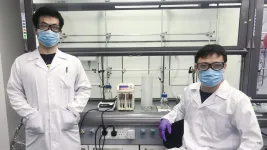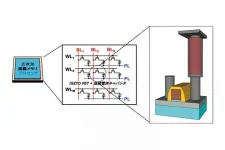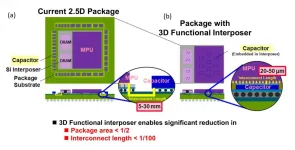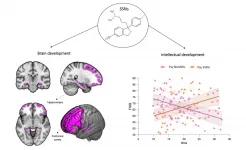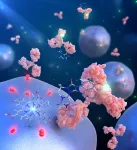(Press-News.org) Our lives today are governed by electronics in all shapes and forms. Electronics, in turn, are governed by their batteries. However, the traditional lithium-ion batteries (LIBs), that are widely used in electronic devices, are falling out of favor because researchers are beginning to view lithium metal batteries (LMBs) as a superior alternative due to their remarkably high energy density that exceeds LIBs by an order of magnitude! The key difference lies in the choice of anode material: LIBs use graphite, whereas LMBs use lithium metal.
Such a choice, however, comes with its own challenges. Among the most prominent ones is the formation of needle-like structures on the lithium anode surface during cycling called "dendrites" that tend to pierce the barrier between the anode and cathode, causing short-circuit and, consequently, safety issues. "Li dendrite formation is strongly dependent on the surface nature of lithium anodes. A crucial strategy for LMBs, therefore, is to build an efficient solid-electrolyte interface (SEI) at the lithium surface," explains Prof. Yong Min Lee from Daegu Gyeongbuk Institute of Science and Technology (DGIST), Korea, who specializes in battery design.
Accordingly, researchers have explored a variety of strategies, from 2D interfacial engineering to 3D lithium anode architecture. In each case, solving one problem has merely given way to another. However, a new approach based on lithium metal powder (LMP) composite electrodes promises to stand out. The appeal of LMP lies in their spherical shape, which results in higher surface area, and ease of thickness tunability, allowing for wider and thinner electrodes. However, problems with LMP use still exist, such as the morphological failure caused by the inherent nature of their uneven surface.
Now, in a new study published in Advanced Energy Materials, Dr. Lee, along with researchers from Korea, adopted a novel approach in which they pre-planted LiNO3 to the LMP itself during the electrode fabrication process, allowing them to fabricate ~150-mm-wide and 20-μm-thick electrodes, which showed a coulombic efficiency of 96%.
The addition of LiNO3 to LMP accomplished two things: it induced a uniform N-rich SEI on the LMP surface and led to its sustained stabilization over prolonged cycling as LiNO3 was steadily released into the electrolyte. In fact, LMBs with LiNO3 pre-planted LMP (LN-LMP) demonstrated an outstanding cycling performance, with 87% capacity retention over 450 cycles, outperforming even cells with LiNO3-added electrolytes.
Prof. Lee is thrilled by these findings and speaks of their practical ramifications. "We expect that pre-planting Li stabilized additives into the LMP electrode would be a stepping-stone towards the commercialization of large-scale Li-metal, Li-S, and Li-air batteries with high specific energy and long cycle life," he says.
With respect to batteries, it looks like lithium is not going out of fashion anytime soon!
INFORMATION:
Reference
Authors: Dahee Jin1, Youngjoon Roh1, Taejin Jo2, Myung-Hyun Ryou3, Hongkyung Lee1,4 and Yong Min Lee1,4
Title of original paper: Robust Cycling of Ultrathin Li Metal Enabled by Nitrate-Preplanted Li Powder Composite
Journal: Advanced Energy Materials
DOI: 10.1002/aenm.202003769
Affiliations: 1Department of Energy Science and Engineering, Daegu Gyeongbuk Institute of Science and Technology (DGIST)
2Iljin Materials
3Department of Chemical and Biological Engineering, Hanbat National University
4Energy Science and Engineering Research Center, Daegu Gyeongbuk Institute of Science and Technology (DGIST)
*Corresponding author's email: mhryou@hanbat.ac.kr; hongkyung.lee@dgist.ac.kr; yongmin.lee@dgist.ac.kr
About Daegu Gyeongbuk Institute of Science and Technology (DGIST)
Daegu Gyeongbuk Institute of Science and Technology (DGIST) is a well-known and respected research institute located in Daegu, Republic of Korea. Established in 2004 by the Korean Government, the main aim of DGIST is to promote national science and technology, as well as to boost the local economy.
With a vision of "Changing the world through convergence", DGIST has undertaken a wide range of research in various fields of science and technology. DGIST has embraced a multidisciplinary approach to research and undertaken intensive studies in some of today's most vital fields. DGIST also has state-of-the-art-infrastructure to enable cutting-edge research in materials science, robotics, cognitive sciences, and communication engineering.
Website: https://www.dgist.ac.kr/en/html/sub01/010204.html
About the author
Dr. Yong Min Lee is currently an Associate Professor at the Department of Energy Science and Engineering in DGIST, Republic of Korea, since 2017. He earned his Ph.D. at Korea Advanced Institute of Science and Technology (KAIST), Republic of Korea, in 2007. His research interests are functional materials for batteries, battery design/advanced analysis, and 3D modeling/simulations. He has published 167 papers with over 6800 citations to his credit and is a recipient of several awards, including the latest research award in 2020 and the best lecture award in 2019.
Singapore, 1 June 2021 - The discovery and development of new small-molecule compounds for therapeutic use involves a huge investment of time, effort and resources. Giving a new spin to conventional chemical synthesis, a team of researchers from the National University of Singapore (NUS) has developed a way to automate the production of small molecules suitable for pharmaceutical use. The method can potentially be used for molecules that are typically produced via manual processes, thereby reducing the manpower required.
The research team that achieved this technological breakthrough was led by Assistant Professor Wu Jie from the NUS Department of Chemistry as well as Associate Professor Saif A. Khan from ...
Bribery in the public healthcare does not solve the problem of poor quality of services, and even exacerbates it, researchers argue. The same can be said about the well-being of patients and their own assessment of health. In other words, bribes in the healthcare do not provide good quality services and do not pay off. Such conclusions were reached by an international team of researchers, including Olga Popova, the article's co-author, an associate professor at the Ural Federal University (UrFU, Russia).
Researchers examined survey data on 41,000 citizens from 28 post-communist countries in Central and Eastern Europe, as well as ...
Tokyo - Machine learning is the process by which computers adapt their responses without human intervention. This form of artificial intelligence (AI) is now common in everyday tools such as virtual assistants and is being developed for use in areas from medicine to agriculture. A challenge posed by the rapid expansion of machine learning is the high energy demand of the complex computing processes. Researchers from The University of Tokyo have reported the first integration of a mobility-enhanced field-effect transistor (FET) and a ferroelectric capacitor (FE-CAP) to bring the memory system into the proximity of a microprocessor and improve the ...
In the modern day, our interactions with voice-based devices and services continue to increase. In this light, researchers at Tokyo Institute of Technology and RIKEN, Japan, have performed a meta-synthesis to understand how we perceive and interact with the voice (and the body) of various machines. Their findings have generated insights into human preferences, and can be used by engineers and designers to develop future vocal technologies.
As humans, we primarily communicate vocally and aurally. We convey not just linguistic information, but also the complexities of our emotional states and personalities. Aspects of our voice such as tone, rhythm, and pitch are vital to the way we are perceived. In other words, the way we say things matters.
With advances in ...
Magnetic fields are ubiquitous throughout our Milky Way Galaxy and play a crucial role in all dynamics of interstellar medium. However, questions like how Solar-type stars form out of magnetized molecular clouds, whether the role of magnetic fields changes at various scales and densities of molecular clouds, and what factors can change the morphology of magnetic fields in low-mass dense cores still remain unclear.
A new study led by Dr. Eswaraiah Chakali from Prof. LI Di's research group at the National Astronomical Observatories of the Chinese Academy of Sciences (NAOC) has partially answered these questions. ...
Scientists at Tokyo Institute of Technology develop a 3D functional interposer--the interface between a chip and the package substrate--containing an embedded capacitor. This compact design saves a lot of package area and greatly reduces the wiring length between the chip's terminals and the capacitor, allowing for less noise and power consumption. Their approach paves the way to new semiconductor package structures with greater miniaturization.
Electronics started big size-wise but have only grown smaller and more compact over time. Today, even smartphones outperform the bulky computers from the 1980s by orders of magnitude. Unfortunately, ...
Up to three quarters of the biodiversity living on Western Australia's iconic ironstone mountains in the State's Mid West (known as Banded Iron Formations) could be difficult or impossible to return quickly to its previous state after the landscape has been mined, a Curtin University study has found.
The research published in Ecology and Evolution, discovered that the plant ecosystems are well-adapted to the characteristics of the region's ancient and nutrient-poor soils - and that the very different features of mined landscapes mean many native species are unlikely to be returned by rehabilitation.
Lead researcher Dr Adam Cross ...
One person in 2000 suffers from a microdeletion of chromosome 22 that can lead to the development of psychotic disorders, such as schizophrenia, in adolescence. In addition to symptoms such as hallucinations or delusions, psychotic disorders also comes with a progressive decline in intelligence quotient (IQ). If current drug treatments are successful in containing psychotic symptoms, nothing can be done to prevent the deterioration of intellectual skills that leads to loss of autonomy. Researchers at the University of Geneva (UNIGE), Switzerland, have discovered that prescription of selective serotonin reuptake inhibitors (SSRIs) - a class of drugs used to treat anxiety and depression -in late childhood can reduce the deterioration ...
ALS is a very severe neurodegenerative disease in which nerve cells in the spinal cord controlling muscles and movement slowly die. There is no effective treatment and the average life expectancy after being diagnosed with ALS is usually short. Because of this, new knowledge about the disease is urgently needed.
Now, researchers from the University of Copenhagen have gained new insights about ALS, by investigating the early development of the disease in a mouse model.
"We have found that networks of nerve cells in the spinal cord called inhibitory interneurons lose connection to motor neurons, the nerve ...
Researchers have created a new nanometer-scale proximity labeling system that targets histidine residues quickly, providing a new chemical tool in protein chemical modification.
The results of their research were published in the Journal of the American Chemical Society on April 27, 2021.
Protein chemical modification, a technology that introduces functions into the chemical structure of proteins through irreversible strong bonds, is used for the creation of protein-based biomaterials and for drug delivery systems.
In order to carry out modification, protein labeling is necessary. Proximity labeling is one of those techniques. It labels biomolecules located close to a protein of interest which can then also be marked ...

